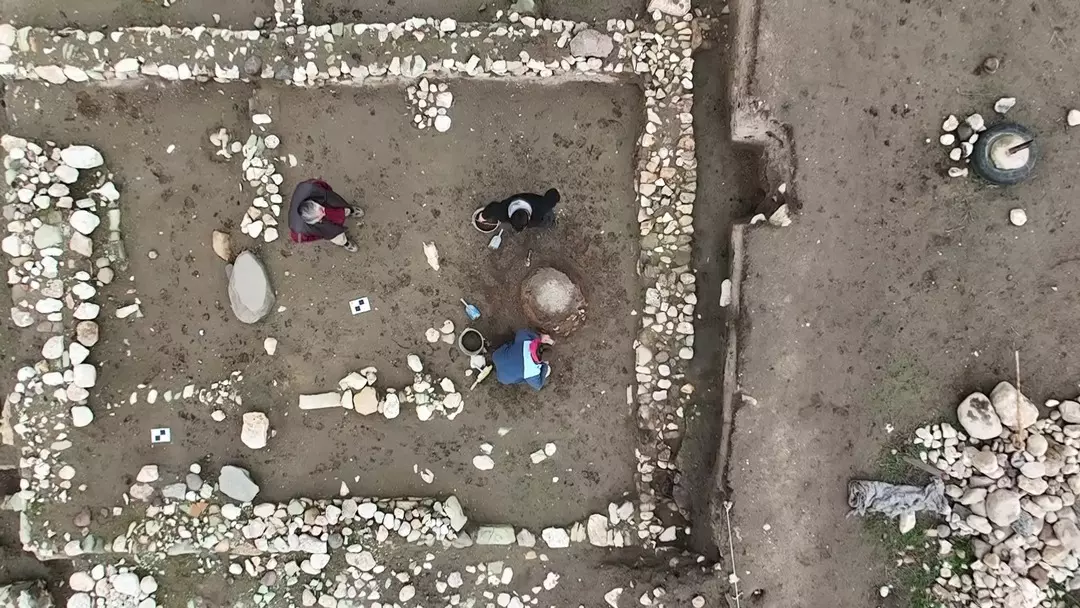Ancient Pompeii home with 'untouched' frescoes of mythological scenes uncovered by archaeologists 2,000 years after being buried in volcanic rubble
A small home in the ancient Roman city of Pompeii filled with untouched frescoes of mythological scenes has been uncovered by archaeologists after being buried under volcanic rubble for 2,000 years.
The richly decorated dwelling, called the House of Phaedra after the mythological queen of Athens who features in one of its wall paintings, was discovered on Thursday, according to the site.
It sheds light on changing architectural styles in the first century AD, and unlike many of the houses excavated at the site, it was not built around the traditional Roman atrium, an open space with a pool for collecting rain water, the Pompeii archaeological park said in a statement.
One of the frescoes found at the small house in Pompeii. Courtesy of the Archaeological Park of Pompeii
Despite its small size, the house 'strikes us for the high level of its wall decorations,' the statement said, noting they were of similar quality to much larger and more opulent homes near the new discovery, which lies in the centre of the site.
Besides the fresco of Phaedra and Hippolytus, who spurned her love, other mythological scenes adorning the vividly coloured walls of the house include a sexual encounter between a satyr and a nymph, and gods who the site said may have been Venus and Adonis.
A detail of a richly decorated but uncommonly small house with finely preserved frescoes of mythological scenes is pictured in the archaeological site in Pompeii, Italy
The dwelling, called the House of Phaedra after the mythological queen of Athens who features in one of its wall paintings, was discovered on Thursday
Despite its small size, the house 'strikes us for the high level of its wall decorations,' the Pompeii archaeological park said in a statement
One depicts a sexual encounter between a satyr and a nymph, and gods who the site said may have been Venus and Adonis
The house sheds light on changing architectural styles in the first century AD
The building also boasts numerous smaller, but detailed and beautifully preserved patterns and scenes from nature.
The once-thriving city of Pompeii and the surrounding countryside in southern Italy was submerged by volcanic ash when Mount Vesuvius exploded in A.D. 79.
The eruption killed thousands of Romans who had no idea they were living in the shadow of one of Europe's biggest volcanoes.
It buried the city in a thick layer of ash, preserving many of its residents and buildings.
Images of sexual positions have been found in a private home near Pompeii as well as in the city’s brothel.
Apart from their relaxed attitude to sex, Pompeiians painted phallic symbols on their homes in the belief they brought wealth, fertility and good luck.
The latest find comes six months after archeologists uncovered remarkably preserved fresco paintings on a wall at a former private residence along Via di Nola, one of Pompeii's longest streets, in April.
One of the stunning artworks depicted Helen of Troy, a beautiful woman in Greek mythology, meeting Paris, prince of Troy, for the first time.
According to legend, the resulting elopement between the two sparked the Trojan War of the 12th century BC.
It's one of many buried treasures found at the Italian former city, which was famously destroyed by the lethal eruption of Mount Vesuvius.
The frescos were been discovered in the 'black room', an 'imposing' banquet hall with elegant black walls at a former private residence along Via di Nola.
Painted onto a black background, the scene shows Helen of Troy, a beautiful woman in Greek mythology (left with a nurse or maid), meeting Paris, prince of Troy (right with his dog). The little Greek writing says: Alexander Helen. Alexander is another name for Paris
A second fresco in the black room, meanwhile, depicts the naked Greek god Apollo trying to seduce the priestess Cassandra
Here, Leda, mother of Helen of Troy is about to conceive with Greek god Zeus disguised as a randy swan
A fourth fresco, uncovered from the ancient volcanic material in April, shows a female figure appearing to hold a dish
It is called the black room because it was painted black, likely to mask soot from oil lamps that would have burnt.
Conversely, the room's mosaic floor is comprised of more than a million tiny and intricately arranged white tiles.
'Here people gathered to feast after sunset, the flickering light of the oil lamps made the images seem to move, especially after a few glasses of good Campania wine,' said Gabriel Zuchtriegel, director of the Archaeological Park of Pompeii, at the time of the discovery.
A second fresco was unearthed in the room, which depicted the naked Greek god Apollo trying to seduce the priestess Cassandra.
Dr Andrew Sillett, a classics lecturer at the University of Oxford, has described the frescos as 'pretty cool' because they were likely done close to the eruption.
'Most paintings we have are somewhat worn as a result of having been painted years before,' he told MailOnline.
'It looks like these were buried very shortly after having been painted.'
A third fresco in the black room, meanwhile, showed Leda, mother of Helen of Troy.
And a fourth fresco, which is barely uncovered from the ancient volcanic material, showed a female figure appearing to hold a dish.

















